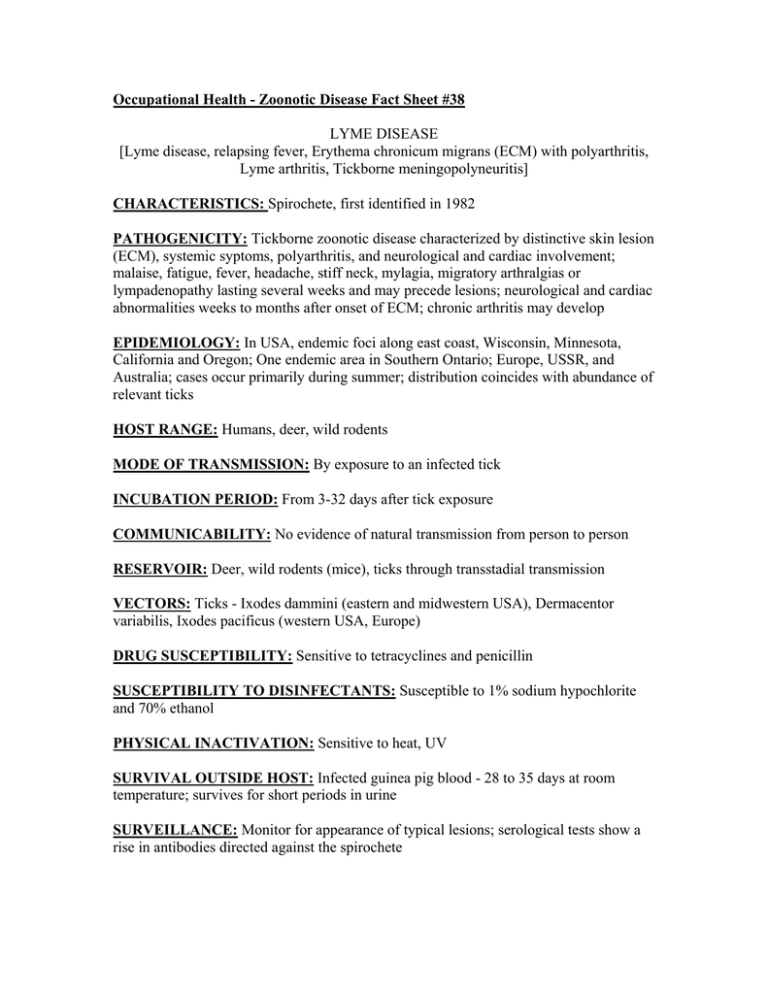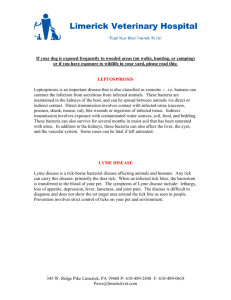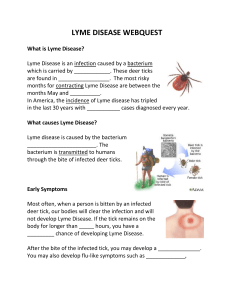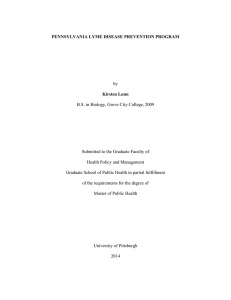Occupational Health - Zoonotic Disease Fact Sheet #38 LYME DISEASE
advertisement

Occupational Health - Zoonotic Disease Fact Sheet #38 LYME DISEASE [Lyme disease, relapsing fever, Erythema chronicum migrans (ECM) with polyarthritis, Lyme arthritis, Tickborne meningopolyneuritis] CHARACTERISTICS: Spirochete, first identified in 1982 PATHOGENICITY: Tickborne zoonotic disease characterized by distinctive skin lesion (ECM), systemic syptoms, polyarthritis, and neurological and cardiac involvement; malaise, fatigue, fever, headache, stiff neck, mylagia, migratory arthralgias or lympadenopathy lasting several weeks and may precede lesions; neurological and cardiac abnormalities weeks to months after onset of ECM; chronic arthritis may develop EPIDEMIOLOGY: In USA, endemic foci along east coast, Wisconsin, Minnesota, California and Oregon; One endemic area in Southern Ontario; Europe, USSR, and Australia; cases occur primarily during summer; distribution coincides with abundance of relevant ticks HOST RANGE: Humans, deer, wild rodents MODE OF TRANSMISSION: By exposure to an infected tick INCUBATION PERIOD: From 3-32 days after tick exposure COMMUNICABILITY: No evidence of natural transmission from person to person RESERVOIR: Deer, wild rodents (mice), ticks through transstadial transmission VECTORS: Ticks - Ixodes dammini (eastern and midwestern USA), Dermacentor variabilis, Ixodes pacificus (western USA, Europe) DRUG SUSCEPTIBILITY: Sensitive to tetracyclines and penicillin SUSCEPTIBILITY TO DISINFECTANTS: Susceptible to 1% sodium hypochlorite and 70% ethanol PHYSICAL INACTIVATION: Sensitive to heat, UV SURVIVAL OUTSIDE HOST: Infected guinea pig blood - 28 to 35 days at room temperature; survives for short periods in urine SURVEILLANCE: Monitor for appearance of typical lesions; serological tests show a rise in antibodies directed against the spirochete FIRST AID/TREATMENT: Treatment of ECM stage with tetracycline for adults and penicillin for children may prevent or lessen the severity of the major late cardiac, neurologic or arthritic complications IMMUNIZATION/PROPHYLAXIS: SmithKline Beecham's LYMErix(TM), one of two vaccines developed to prevent Lyme disease, was recently approved by the FDA and is now available to the public. A second Lyme disease vaccine, ImuLyme(TM) (manufactured by Pasteur Merieux Connaught) is still awaiting FDA approval. Both vaccines are based on recombinant Borrelia burgdorferi Outer Surface Protein A, or Osp A (SmithKline Beecham's vaccine also includes an adjuvant), and are designed to kill the disease-causing spirochete within the tick before it can enter the human bloodstream. Neither vaccine will initially be available to children under the age of 15, and both currently require 3 injections over a 12-month period to build immunity to its peak level. It has not yet been determined conclusively how often additional booster shots will be needed in subsequent years. PROTECTIVE CLOTHING: Laboratory coat; gloves should be worn during necropsy of infected animals and when contact with infectious materials is unavoidable CONTAINMENT REQUIREMENTS: Biosafety Level 2 practices, containment equipment and facilities for activities involving known or potentially infectious materials, including necropsy of infected animals





